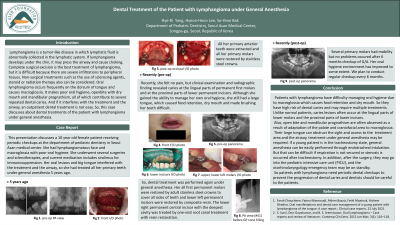Caries
430 - Dental Treatment of the Patient with Lymphangioma under General Anesthesia

- HY
Hyeri Yang, DDS (she/her/hers)
resident
the Department of Pediatric Dentistry in Seoul Asan Medical Center, Songpa-gu, Seoul
Seoul Asan medical center
Songpa-gu, Seoul-t'ukpyolsi, Republic of Korea - hl
hyeon-heon lee, DDS
Asan Medical Center
- sb
so-yeon bak, DDS
Asan Medical Center
- SB
So-Yeon Bak, DDS
the Department of Pediatric Dentistry in Asan Medical Center, Songpa-gu, Seoul
Songpa-gu, Seoul-t'ukpyolsi, Republic of Korea - HL
Hyeon-Heon Lee, DDS
the Department of Pediatric Dentistry in Asan Medical Center, Songpa-gu, Seoul
Songpa-gu, Seoul-t'ukpyolsi, Republic of Korea
Presenting Author(s)
Co-Author(s)
Research Mentor(s)
Program Director(s)
Introduction: Lymphangioma is a tumor-like disease in which lymphatic fluid is abnormally collected in the lymphatic system. Complete surgical excision is the best treatment of lymphangioma, but it is difficult because there are severe infiltrations to peripheral tissues. Oral lymphangioma occurs frequently on the dorsum of tongue and causes macroglossia. It makes poor oral hygiene, openbite with dry mouth and mandibular prognathism, all of which contribute to severe dental caries.
Case Report: This presentation discusses a 10 year old female patient receiving periodic checkups at the department of pediatric dentistry in Asan medical center. She had lymphangiomatous face and macroglossia with poor oral hygiene. She underwent several surgeries and sclerotherapies, and current medication includes sirolimus for immunosuppression. Her oral lesions and big tongue interfered with the treatment and the airway, so she had treated all her primary teeth under general anesthesia 5 years ago. Recently, she felt no pain, but clinical examination and radiographic finding revealed caries in the lingual part of permanent first molars and in the proximal part of lower permanent incisors. So, dental treatment was performed again under general anesthesia. Her all permanent first molars were restored by adult stainless steel crown and lower left incisors were restored by composite resin. The lower right central incisor with the cavity was treated by 1-visit root canal treatment with resin restoration. No problems occur after 6 months of surgery. This report will include clinical findings associated with lymphangioma and treatment rendered to our patient.
Identify Supporting Agency and Grant Number:

.jpg)